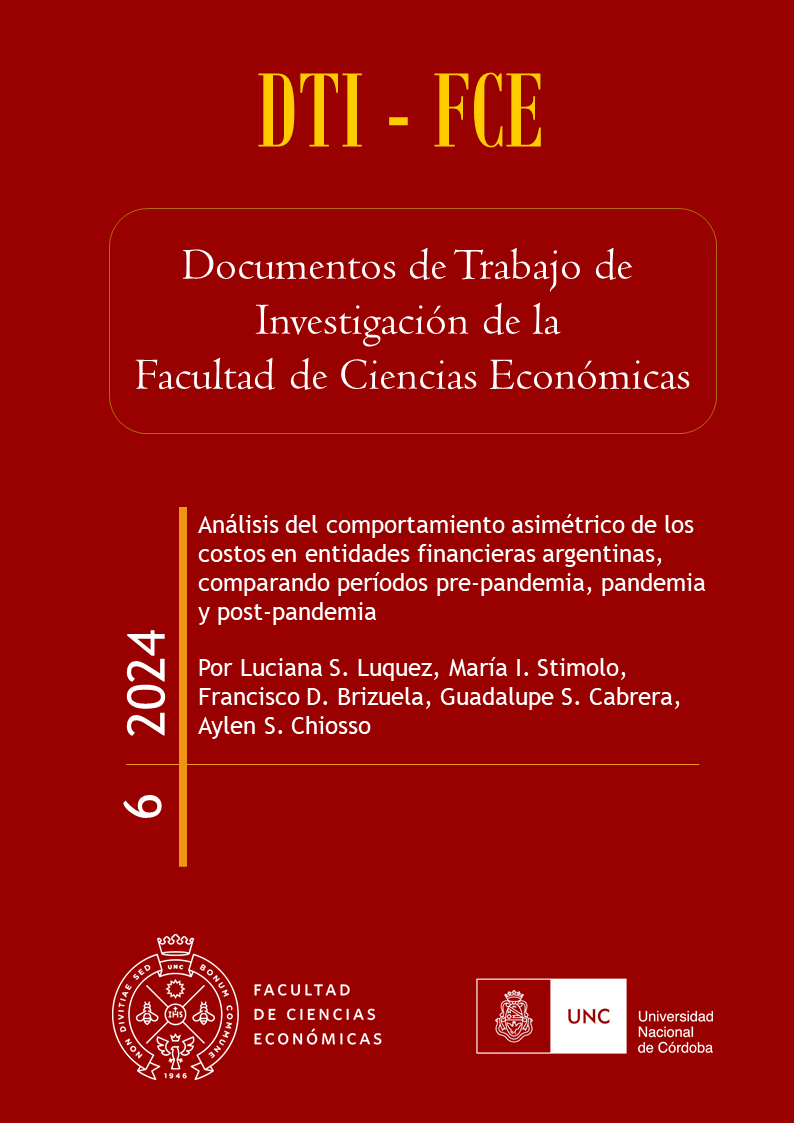Análisis del comportamiento asimétrico de los costos en entidades financieras argentinas, comparando períodos pre-pandemia, pandemia y post-pandemia
Keywords:
Costos asimétricos, Entidades financieras, PandemiaAbstract
The short-term cost function assumes a symmetric proportionality between costs and activity level, that is cost change (increase or decrease) in the same proportion and direction when the company's level of activity changes. However, in practice, costs do not comply with this symmetric proportionality and present a different behaviour depending on the direction of change in the activity level.
This paper analyzes the asymmetric behaviour of total costs in financial entities in Argentina, comparing pre-pandemic, pandemic and post-pandemic periods.
The empirical regression model (ABJ model) based on the theory of management decisions, proposed by Anderson et al. (2003), was used to measure the behaviour of costs. The results indicated a lower asymmetry cost in pandemic and post-pandemic period.
Downloads
References
Anderson, M.C., Banker, R. D. y Janakiraman, S. N. (2003). ¿Are Selling, General and Administrative Costs “Sticky”?. Journal of Accounting Research, 41(1), pp. 47-63.
Anderson, S.W. y Lanen, W.N. (2007). Understanding Cost Management: What can We Learn from the Evidence on “Sticky Costs”?. Disponible en: https://papers.ssrn.com/sol3/papers.cfm?abstract_id=975135 [consulta: 15 abril 2024].
Anderson, M., Asdemir, O., Arindam, T. (2013). Use of precedent and antecedent information in strategic cost management. Journal of Business Research, 66(5), pp. 643-650. http://dx.doi.org/10.1016/j.jbusres.2012.08.021 [consulta: 15 abril 2024].
Balakrishnan, R., Labro, E. y Soderstrom, N. S. (2014). Cost Structure and Sticky Costs. Journal of Management Accounting Research, 26(2), pp. 91–116. Disponible en: https://papers.ssrn.com/sol3/papers.cfm?abstract_id=1562726 [consulta: 15 abril 2024].
Banker, R. D. y Byzalov, D. (2014). Asymmetric cost behavior. Journal of Management Accounting Research, 56(2), pp. 43-79.
Ekicia, E., Zhang, J y Han, J. (2024). The impact of cost resilience on management decision to respond to the COVID-19 crisis in healthcare companies. International Journal of Healthcare Management. https://doi.org/10.1080/20479700.2024.2318512 [consulta: 15 abril 2024].
Finne, G., Haga, J. y Sundvik, D. (2023). Cost behaviour and reporting frequency during the COVID-19 outbreak. Accounting and Business Research, Forthcoming. Disponible en:
https://papers.ssrn.com/sol3/papers.cfm?abstract_id=4422731 [consulta: 15 abril 2024].
Fondo Monetario Internacional (2020). FMI Informe Corporate Financial. Disponible en:https://drive.google.com/file/d/1lnDfbQAtVTKmdbxV6GiGJFlpbBNk6rSM/view?pli=1 [consulta: 15 abril 2024].
Kwak, J.-Y., Lee, J., y Jo, E. H. (2021). Impact of COVID-19 on R&D Cost Stickiness in IT industry. International Journal of Internet, Broadcasting and Communication, 13(2), pp. 36-42.
Park, W. (2022). The Effect of COVID-19 Pandemic and Operanting Cycle on Asymmetric Cost Behavior in Food Service Industry. Journal of Digital Convergence, 20(4), pp. 215-224.
Piatti, D., Cincinelli, P., Cattaneo, C. y Bassani, G. (2022). Sticky costs in the Italian banking system. Disponible en: https://ssrn.com/abstract=4280365 [consulta: 15 abril 2024].
Porporato, M. y Werbin, E. (2012). Evidence of Sticky Costs in Banks of Argentina, Brazil and Canada. International Journal of Financial Services Management, 5(4), pp. 303-320.
Ribeiro de Medeiros, O. y De Souza Costa, P. (2004). Cost Stickiness in Brazilian Firms. Disponible en: https://ssrn.com/abstract=632365 [consulta: 15 abril 2024].
Soegiharto, M. y Rachmawati, D. (2022). Sticky cost determinants: Which one has the stronger impact?. The Indonesian Accounting Review, 12(2), pp. 189-202.
Stimolo, M. I. y Porporato, M. (2020). How different cost behaviour is in emerging economies? Evidence from Argentina. Journal of Accounting in Emerging Economies, 10(1), pp. 21-47.
Stimolo, M. I. y Díaz, M. (2017). Comportamiento asimétrico de los costos en empresas argentinas listados en el mercado de valores de los sectores construcción, comercio y servicios. Cuadernos del Cimbage, 19, pp. 43-65.
Vela-Beltrán-del-Río, C. y Llanos Reynoso, L. F. (2018). The Deceitfulness of Sticky Costs on Banking Systems. Journal of Accounting Business and Management, 25(2), pp. 61-80.
Werbin, E. y Porporato, M. (2012). Active cost management in Argentinean banks: an empirical test of sticky costs. International Journal of Economics and Business Research, 4(6), pp. 679-703.
Werbin, E. (2009). Los costos pegadizos (sticky costs): Una prueba empírica en bancos argentinos. Revista Iberoamericana de Contabilidad de gestión, 7(14), pp. 1-9. Disponible en: https://dialnet.unirioja.es/servlet/articulo?codigo=6579727 [consulta: 15 abril 2024].
Werbin, E., Marín Vinuesa, L. M. y Porporato, M. (2012). Costos pegajosos (sticky costs) en empresas españolas: un estudio empírico. Contaduría y Administración, 57(2), pp. 185-200. Disponible en: http://www.cya.unam.mx/index.php/cya/article/view/190
Yang, Y. y Chen, D. (2024). Influence of COVID-19 on asymmetric cost behavior and intellectual capital efficiency: a comparison of Australian and Chinese listed firms. Asia-Pacific Journal of Accounting & Economics, 31(3), pp. 477-493. https://doi.org/10.1080/16081625.2023.2194887.
Additional Files
Published
Issue
Section
License
Copyright (c) 2024 Documentos de Trabajo de Investigación de la Facultad de Ciencias Económicas (DTI-FCE)

This work is licensed under a Creative Commons Attribution-NonCommercial-NoDerivatives 4.0 International License.






